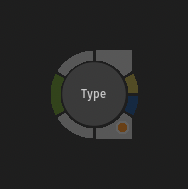Type

Use the Type node to add text, titles, rolls, and crawls to a clip or sequence.

| Access | To access the Type menu, use:
|
| Input | Back - The clip to add text, titles, rolls, or crawls to. This input is optional. In Batch and Batch FX, if no clip is connected, the text, titles, rolls, or crawls are added on a black background. |
| Outputs |
|
The node inherits the resolution and colour space of the clip connected to the Back input, if any. If no clip is connected to the Back input, the project's resolution and colour space are used, and can be modified from the Node Prefs menu.

Modifying a Setup from the Timeline
Controls for the Type Timeline FX are accessible from the Timeline FX Ribbon. Layers cannot be added or deleted, but can be selected using the drop-down button located in the Layers submenu.
Viewing Text in a Viewport
A viewport showing one of the Type tool's output views, Result or OutMatte, can be set to Interactive or Live Preview mode using a switch at the bottom-left of a viewport. This is the equivalent to the 3D and Live Preview modes available in the Action tool.
- In Interactive mode, no anti-aliasing or shadow blur is applied, and the layers outside of the background canvas are visible.
- In Live Preview mode, you see the output of the node, including the anti-aliasing.
Notes:
- Avoid using Live Preview mode when the Batch Cache is enabled on a Type node, as using both will impact the interactivity.
- When adding content to a Roll Layer while the viewport is set to Live Preview, the roll does not automatically scroll when you add lines or navigate through lines. It is recommended to use the Interactive mode to achieve this task.
Node Preferences
Parameters in the Node Prefs menu can be used to adjust the node's format, rendering, and display.

Resolution
Select an output resolution for the node. The node inherits the resolution of the background if a clip is connected.
Tagged Colour Space
Select a colour space for the node. The node inherits the colour space of the background if a clip is connected.
Scan Format
Scan Format Mode option
Select whether to render in Progressive or Interlaced mode. Automatic makes the selection using the scan mode of the clip connected to the Back input.
Hardware Anti-Aliasing
Use HWAA
Enable to apply the hardware anti-aliasing level set in the Rendering tab of the Project Preferences to this Type setup.
Hardware Anti-Aliasing indicator
Displays the hardware anti-aliasing level set in the Rendering tab of the Project Preferences.
Software Anti-Aliasing
Software Anti-Aliasing option
Select the software anti-aliasing sampling level. Higher values produce better results, but may have an impact on the performance.
Path Colours
Path Wireframe colour
Sets the colour of the text motion path.
Path Vertices colour
Sets the colour of the vertices on a text motion path.
Characters Position
Outlines colour
Sets the colour of the outlines that show the original position of a character if it has been moved using the parameters in the Characters Axis menu.
Output
Output option
Select whether the front (RGB), matte (A Only), or both (RGBA) is output.
Motion Blur 
Active
Enable to apply a motion blur effect to all moving layers and characters of the setup.
Samples field
Sets the quality of motion blur produced by the number of samples taken at each frame.
The number of motion blur samples is multiplied by the number of anti-aliasing samples. To reduce the total number of passes made for each frame, reduce the level of anti-aliasing when Motion Blur is enabled.
Phase field
Sets the frame that motion blur is based on (before or after the current frame).
A value of -1.0 places the motion blur before while a value of 1.0 places the motion blur after. A value of 0.0 is centred, which evenly distributes the motion blur.
Shutter field
Sets the duration of motion blur at each frame (essentially the number of frames that the shutter is open). Increasing this value does not increase the processing time.
Reset Options
To reset selected layers, click Rst Layer at the bottom-right of the user interface. To reset specific parts of the selected layers, select one of these options in the drop-down attached to Rst Layer:
| Select: | To: |
|---|---|
| Reset Attributes | Reset all parameters other than the Paragraph Justification in the Attributes menu. |
| Reset Axis | Reset all parameters in the Axis menu. |
| Reset Cascade | Reset all parameters in the Cascade menu. |
| Reset Roll / Crawl | Reset all parameters in the Roll / Crawl menu. |
Keyboard Shortcuts
Contrary to the legacy Text tool from previous versions, the Type tool is integrated into Batch. Therefore, some keyboard shortcuts for functions that were previously available in the Text tool have been modified to avoid conflicts with other Batch features. Please consult the Keyboard Shortcut Editor while the Type tool is focused for the complete list of keyboard shortcuts.
Tangent Panels
The Type Timeline FX can be added from a Tangent panel, replacing the Text Timeline FX.
Python API
Attributes and functions for the Type tool are available in the Python API. For more details, see What's New in the Python API.
For more information on the Type tool, see:
